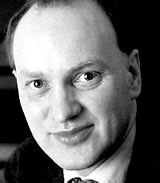Breaking the jelly mould
Some folk may find the concept a trifle confusing, but, explains Hugh Pearman, cities and their public spaces are analogous to a children’s old favourite dessert

Objects surround us, people like me write about objects, there’s a neatness about something that is whole in itself. A car. A building. A corporate logo. A chair. Though think of all these things not as designed objects but as universal particles or atoms, and you’re left with that unanswerable child’s question: what’s in between atoms?
The answer ‘nothing’ is no good really. Even the Encyclopaedia Britannica dodges the issue when it delves inside the atom, looks at all the funny things whizzing around in there, and declares: ‘Most of the atom is empty space’. It’s a conundrum. To have a concept of a thing, you also have to have a concept of a no-thing. But a moment’s thought reveals this to be impossible. Total emptiness, the absence of everything? We can’t get our heads round that. Outer space used to be described as being like a vacuum. Then scientists found all sorts of interesting stuff flowing around in space, so now there’s a concept of space being like a very thin jelly with bits of fruit in it. You can see the bits, you just can’t see the jelly.
Cities are the same. The space between things in our physical surroundings – the public realm – only starts to matter when you stop thinking of it either as being space or of being in between. If you think instead of the civic realm as being just another category of object, and rather more tangible than deep-space thin jelly, then you can do something with it.
People are still surprised that any significant landscape project takes so long and costs so much. A building, now that we can look at and calculate the cost of. But fannying around in open space – how come that costs so much? After all, there’s nothing there, is there? The answer, immediately apparent if you look past your shoelaces, is that there is a lot there. Thomas Heatherwick’s Blue Square in Newcastle, or Foster & Partner’s re-ordering of Trafalgar Square in London, or the restored huge courtyard of Somerset House, or any major urban park or even an apparently untouched stretch of countryside – all are man-made at considerable expense.
With the urban squares, at least you can point to a sub-breed of objects within the space – the equivalent of sub-atomic particles. Squares are full of objects – paving slabs, sculpture, steps, seats, fountains, trees, lighting, inscriptions. Add them all up and soon you realise that such an urban open space is just another building. The things around it are part of it, just as the stands at Old Trafford are as much a part of the stadium as the rectangle of green turf. The square, like the pitch, isn’t space at all, it’s a focal point where things happen.
There are places where the jelly of interstitial space is very thin, where there is no real concept of a public realm at all. I give you Kuala Lumpur, a city of objects set largely in wasteland. The private sector builds the buildings while the streets become mere strips of road for cars, with crumbling concrete sidewalks – or just ground-rubble – filling in the gaps. So un-civic-minded is KL that you have two entirely different ticketing systems for each of the two intersecting metro lines. Which, of course, do not truly intersect, instead avoiding each other by yards.
In Britain, where we’ve had centuries to get used to the idea of public space, we still don’t really understand it. Perhaps this is because of the English informal tradition, which likes to pretend that things that take enormous amounts of effort just sort of happen, as if by magic. This probably explains why the new generation of landscape designers now making names for themselves are big on object-making rather than self-effacement. You would not necessarily notice a Dame Sylvia Crowe landscape from the 1960s. You would certainly notice a West 8 or Kathryn Gustafson landscape from the early 2000s.
It’s a shame in a way, this objectification of landscape – what’s wrong with self-effacement? But let’s not complain. Thanks to excellent groups like West 8 or Gustafson Porter, we are starting to look at this different sort of big design with fresh eyes. It’s not just in-between space after all. Our latest instruments can detect that, instead of being nothing as we previously thought, this civic realm thing actually consists of a highly nutritious jelly full of embedded particles and pulsing with energy. And a city that used to be regarded as just a collection of buildings in space suddenly becomes a lot more interesting.
This opening of eyes is good. Because as soon as people realise there is a ‘there’ there, they start to think of ways to improve it. And the space in between becomes something else. Something valuable.
-
Post a comment



